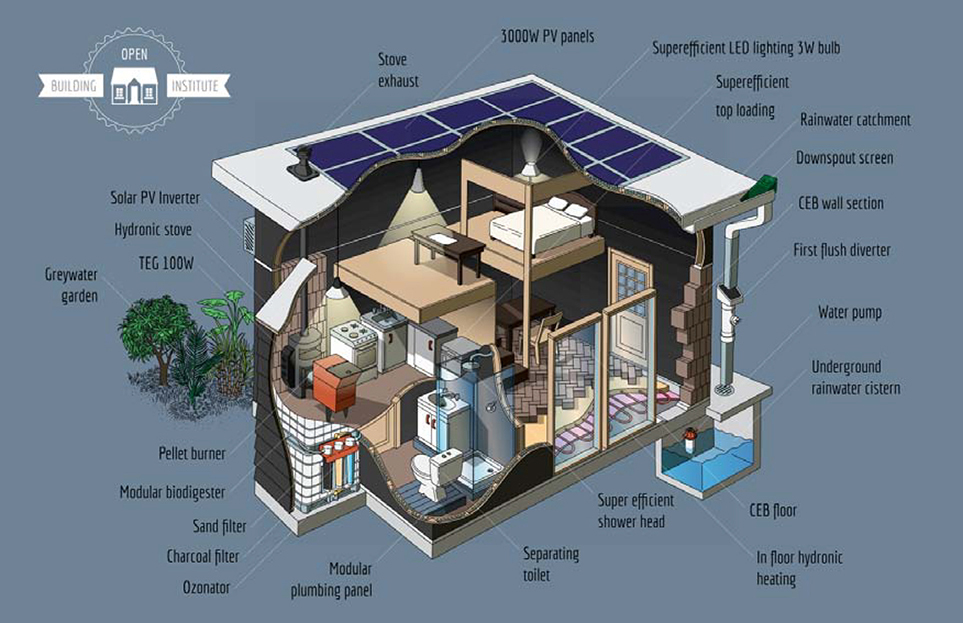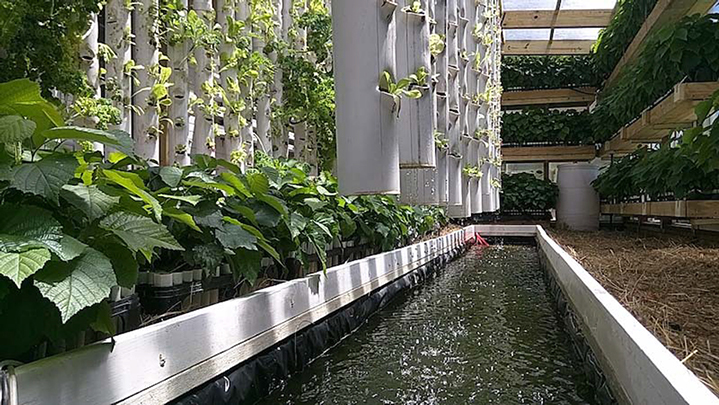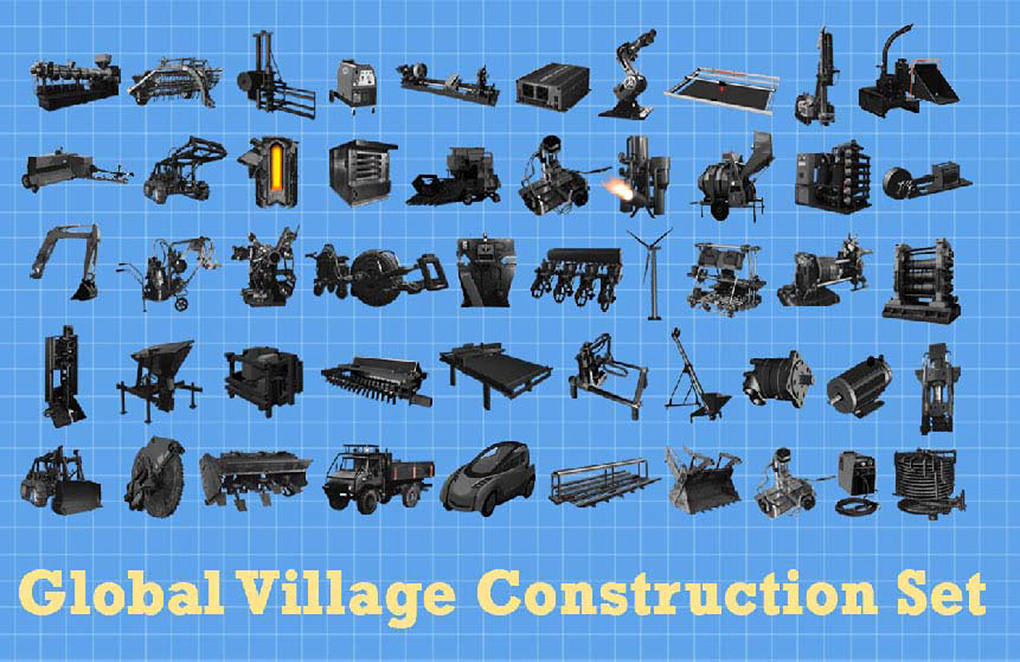CHAPTER 16
Making and Sharing Big Free Stuff
Introduction to Free Big Stuff
We know that free and open-source sharing does not have to stop with immaterial items of value such as code and software; it also can be used to improve innovation and save money on hardware. Many open-hardware projects are small. They could fit in a “bread box”—or at least on a desk. Yet there is no reason that we cannot make large, free hardware as well. In this chapter, we will look at hardware designs for cars, ways to cut the cost of electricity, the Open Building Institute (which is developing a range of house designs), and Open Source Ecology (which is trying to establish the open-source blueprints for the machines that drive civilization itself).
Open-Source Cars
Although the younger generation is often opting to avoid car ownership in favor of ride-sharing services, many people love cars. If you really love cars and would like to help design and build your own, then the Rally Fighter is the project for you! The Rally Fighter (Figure 16.1) was developed by Local Motors (localmotors.com) after only 18 months of development. This constitutes a record time to market compared with automobile industry standards, which are about four times longer. Local Motors was able to bring their car to market so rapidly by applying innovative technologies and open-source crowdsourcing techniques. The Rally Fighter is notably the first production vehicle designed via crowdsourcing (i.e., asking for help from the global community on the internet). The winning design, as a result of a vote from the community, was submitted by Sangho Kim.
Figure 16.1 Rally Fighter. Image by C. Blizzard. (CC BY-SA) https://www.flickr.com/photos/christopherblizzard/5741142315/in/photostream/
In addition to its open-source model of development, Local Motors also has an innovative method to sell the vehicles. The company sells cars as kits that you can then help build! You go to one of Local Motor’s microfactories and assemble your car with help from the company’s team. This also allows the Rally Fighter to be titled a kit car in the United States, so it can be sold without the normal regulations although to be clear, it is street legal in the entire United States. Local Motors is a small automobile company, but it has already made great headway on its next project—Olli, the world’s first cocreated self-driving electric and cognitive shuttle.
Open source is appealing to large automobile companies as well. In 2014, the CEO of Tesla, Elon Musk, announced a radical new patent pledge, saying, “Tesla irrevocably pledges that it will not initiate a lawsuit against any party for infringing a Tesla patent through activity relating to electric vehicles or related equipment for so long as such party is acting in good faith” (Tesla, 2014). Musk explained that the reason the company did this was that “[t]echnology leadership is not defined by patents, which history has repeatedly shown to be small protection indeed against a determined competitor, but rather by the ability of a company to attract and motivate the world’s most talented engineers. We believe that applying the open source philosophy to our patents will strengthen rather than diminish Tesla’s position in this regard” (Musk, 2014). This position has been clarified: Tesla really allows others to use its electric vehicle patents without a formal license (Masnick, 2015). Tesla is not alone—even Toyota has joined the Linux Foundation, a major open-source organization (Vaughan-Nichols, 2011).
OpenEVSE (www.openevse.com) is another open-source company focused on automobiles. This company provides open-source solutions for electric vehicle charging.
If you have not caught the e-car bug yet and you have a “normal” car, you can still add a little open-source magic. For example, OpenXC (openxcplatform.com) is an open-source hardware and software platform that provides a data-focused application programming interface (API) for your car. By installing the OpenXC hardware module, your vehicle data become accessible to open-source Android or other desktop applications using the OpenXC library. OpenXC supports the U.S. federally mandated “on-board diagnostics” data on almost all cars and over an even wider range of data sets on most modern Ford vehicles. This means you can monitor many of the sensors on your car or truck so you can enable new and innovative vehicle-centric applications, learn how to improve your vehicle’s performance, or teach your kids about cars. It even allows you to perform your own diagnostics—no more taking it to the mechanic because the mysterious check engine light is on.
Free Electricity
There is free hardware for several methods of generating electricity, including wind power (OpenSourceLowTech, 2019), but for many sources of renewable power, you have to have a good site, located either on a river or stream or in a nice windy location. Not everyone has this, but most everyone gets a little sunshine. This section therefore concentrates on solar energy and solar photovoltaic (PV) technology in particular. PV devices convert sunlight directly into electricity. Recently, the costs have dropped so radically that PV devices are now the least expensive way of generating electricity (International Renewable Energy Agency [IRENA], 2019). Now—not surprisingly—PV devices have been the fastest-growing energy source for some time (Vaughan, 2017). Although most PV devices are on the grid and part of major solar farms owned by electric utilities, PV systems can be designed for very small applications to provide distributed power generation. For a complete guide to such small systems, see the book To Catch the Sun (Grafman and Pearce, 2020). PV systems have no moving parts, so there is nothing to break. PV systems are also modular. Need more power? Just add another panel. Sunlight is free, so once you purchase the system, you get electricity for 20 years or more. No noise or pollution is created from operating PV systems, so they are really good for the environment. Open-source approaches to PV technology could help scientists to accelerate its development (Buitenhuis and Pearce, 2012), but there are a lot of open-source aspects of PV systems that anyone can use now. For example, many open-source designs are being used to charge cell phones, as we saw in Chapter 2 (see Figure 2.3). There are also scores of open-source electronics designs using PV devices to power everything from toys (ASCAS, 2019) to Chapter 15’s open-source recyclebots (Zhong et al., 2017) and Chapter 12’s 3D printers. An example of the latter is the solar-powered delta-style RepRap that fits in a duffle bag (Figure 16.2) and helps you manufacture the things you need pretty much anywhere (Gwamuri et al., 2016).
Figure 16.2 (a) Photograph of the MOST-delta 3D printer and PV stand-alone power system assembly in transit in a duffel bag. For transportation, the modules are mounted on all three sides of the delta. (b) The same system deployed on a picnic bench. (CC BY-SA) https://www.appropedia.org/High-Efficiency_Solar-Powered_3-D_Printers_for_Sustainable_Development
If you want to power something big, like your house, you need to figure out how many solar panels you need. There are several ways to do free, detailed engineering studies, including the Open Source Solar Advisory Model (SAM) from the U.S. National Renewable Energy Lab (NREL, 2019) (github.com/NREL/SAM). If you just want to do a quick calculation for your home, you are free to use PVWatts (pvwatts.nrel.gov). It is not as powerful as SAM (nor open source, although it uses the same basic equations), but it is good enough to help you calculate approximately how much money you will save.
PV systems generally consist of a PV panel, an inverter (which converts battery-like direct-current [DC] power to wall-outlet-like alternating-current [AC] power), and racking to hold the panels up. It is possible to be off-grid in an isolated system that uses battery backup. Most PV systems today, however, are plugged into the grid so that if you are making solar energy you don’t need, you can share it with your neighbors.
In the not-so-distant past, PV technology was expensive. Not anymore! Today, the cost of PV modules has come down so far that the most expensive part of the system is the rack. For a super-cheap rack for a small, temporary system, you can just prop a panel up against something like a stone or the wall of your house. If you are interested in something a little more permanent and can’t quite afford an amazing solar-powered Tesla roof, open-source designs are available for other building-integrated PV (BIPV) systems (Pearce, Meldrum, and Osborne, 2017). BIPV systems eliminate the need for roofing—the solar panels become the roof. Depending on how you look at it, either you cut your roofing cost or the roof cuts your PV system costs. Ground-mounted systems can be built from treated wood or simple pipes rather than proprietary metal racks for pennies on the dollar.
Open Building Institute
What if you want more than your roof to be open source, sustainable, and cost-effective? You could have a completely open-source house, developed by the Open Building Institute (OBI; www.openbuildinginstitute.org). The basic functionality and details of OBI open-source microhouses are shown in Figure 16.3. There are even open-source plans to monitor all the electric loads and PV generation in the house (Oberloier and Pearce, 2018).
These houses are not only solar-powered, they also collect their own waste water and can be built by you and your friends in multiday microhouse extreme manufacturing workshops. They are full featured, right sized, and classy, and even have a built-in aquaponic greenhouse that can grow food for your family (Figure 16.4). The greenhouse uses passive solar heating for two in-ground fish ponds, a chicken coop connected to an outside run, a rabbit pen, 44 six-foot-tall aquaponic towers, 216 feet of aquaponic troughs, two compost beds, and a potting and seedling area. The greenhouse is designed to produce all the vegetables, mushrooms, and fish that a family might need.
Figure 16.3 Open-source microhouse infographic by Jean-Baptiste Vervaeck, Open Building Institute. (CC BY-SA) https://www.openbuildinginstitute.org/how-it-works/
Figure 16.4 Open-source aquaponic greenhouse, Open Building Institute. (CC BY-SA) https://www.openbuildinginstitute.org/buildings/
Open Source Ecology
Open Source Ecology (OSE; www.opensource ecology.org) actually developed many of the tools OBI needs to fabricate houses. The goal of OSE is to provide open-source blueprints for civilization itself, wherever you happen to live. OSE is doing this by providing the open-source plans for the Global Village Construction Set (Figure 16.5), which consists of 50 of what OSE thinks are the most important devices for modern society. Each open-source device is meant to be modular, able to be built by you, and low cost. Overall, the idea is to have a high-performance platform that allows for the easy fabrication of the 50 industrial machines that it takes to build a small, sustainable civilization with modern comforts. Similar to the lessons we have seen elsewhere in this book, open-source solutions cost a fraction of commercial solutions.
Figure 16.5 The 50 open-source devices in the Global Village Construction Set developed by Open Source Ecology. (CC BY-SA) https://www.opensourceecology.org/gvcs/
There has been steady development of these 50 tools with help from specific open-source communities, including the laser cutter and 3D printers (see Chapter 12). OSE, however, has taken the lead on many of the tools, such as a tractor, backhoe, trencher, ironworker, rototiller, soil pulverizer, and compressed-earth block press, already prototyped and, in several cases (e.g., the tractor in Figure 16.6), replicated all over the world. The 27-horsepower open-source LifeTrac tractor looks a lot like it was built from adult-sized Legos or Tinkertoys. This is exactly the idea! By using a modular design, components can be reused or swapped. Thus, for example, the power cube, which is a modular self-contained universal power unit consisting of an engine coupled with a hydraulic pump, provides power from hydraulic fluids at high pressure through quick-connect hoses. It can be used to power the tractor, but also can be taken off to power other OSE machines.
Figure 16.6 Open-source tractor—the LifeTrac 6—developed by Open Source Ecology. (CC BY-SA) https://opensourceecology.dozuki.com/c/LifeTrac
References
ASCAS. 2019. DIY mini solar car (14kph toy)! Instructables. https://www.instructables.com/id/DIY-Mini-Solar-Car-14kph-Ultrafast-Toy/
Buitenhuis AJ, Pearce JM. 2012. Open-source development of solar photovoltaic technology. Energy for Sustainable Development 16:379–388. http://dx.doi.org/10.1016/j.esd.2012.06.006
Grafman L, Pearce JM. 2020. To Catch the Sun. https://www.appropedia.org/To_Catch_the_Sun
Gwamuri J, Franco D, Khan KY, et al. 2016. High-efficiency solar-powered 3D printers for sustainable development. Machines 4(1):3. http://dx.doi.org/10.3390/machines4010003
International Renewable Energy Agency (IRENA). 2019. Renewables now the lowest-cost power source in most of the world. Institute for Energy Economics and Financial Analysis. http://ieefa.org/irena-renewables-now-the-lowest-cost-power-source-in-most-of-the-world/
Masnick M. 2015. Elon Musk clarifies that Tesla’s patents really are free; investor absolutely freaks out. Techdirt. https://www.techdirt.com/articles/20150217/06182930052/elon-musk-clarifies-that-teslas-patents-really-are-free-investor-absolutely-freaks-out.shtml
Musk E. 2014. All our patents belong to you. https://www.tesla.com/blog/all-our-patent-are-belong-you
SAM Open Source. 2019. System Advisor Model (SAM). https://sam.nrel.gov/about-sam/sam-open-source.html
Oberloier S, Pearce JM. 2018. Open source low-cost power monitoring system. HardwareX 4:e00044. https://doi.org/10.1016/j.ohx.2018.e00044
OpenSourceLowTech. 2019. Wind turbine tutorial. OpenSourceLowTech.org. http://opensourcelowtech.org/wind_turbine.html
Pearce JM, Meldrum J, Osborne N. 2017. Design of post-consumer modification of standard solar modules to form large-area building integrated photovoltaic roof slates. Designs 1(2):9. http://dx.doi.org/10.3390/designs1020009
Tesla. 2014. Patent ledge: privacy and legal. Tesla. https://www.tesla.com/about/legal
Vaughan A. 2017. Time to shine: Solar power is fastest-growing source of new energy. The Guardian. https://www.theguardian.com/environment/2017/oct/04/solar-power-renewables-international-energy-agency
Vaughan-Nichols SJ. 2011. The open-source car: Toyota is joining the Linux Foundation. ZDNet. https://www.zdnet.com/article/the-open-source-car/
Zhong S, Rakhe P, Pearce JM. 2017. Energy payback time of a solar photovoltaic powered waste plastic recyclebot system. Recycling 2(2):10. https://doi.org/10.3390/recycling2020010





